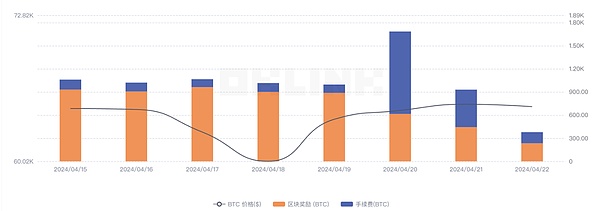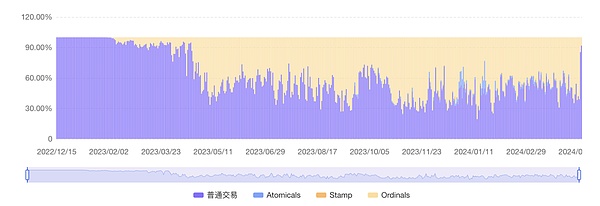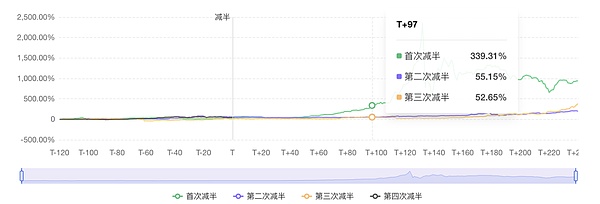According to OKLink data, Bitcoin successfully completed its fourth halving at block height 840000 (8:09 am, April 20, 2024, Beijing time), and the Bitcoin mining reward was officially reduced from 6.25 BTC to 3.125 BTC. After this halving, the Bitcoin inflation rate will also drop from 1.75% to 0.85%, which is expected to be only about 1/2 of the gold supply growth rate, becoming an asset that is truly more scarce than gold.
In theory, the short-term income of Bitcoin miners will be directly affected after the halving. However, due to the rapid growth of Bitcoin on-chain transaction fees in the past two days, the Bitcoin Rune was launched simultaneously with the Bitcoin halving, so that miners did not feel the negative impact of the halving in the first 100 blocks after the halving. On the contrary, they got more than before the halving: On April 20 alone, the on-chain transaction fees generated by the Rune activity accounted for as high as 57.7%; the transaction fees generated by block 840000 reached 37.626BTC, which is about 6 times the block reward before the halving. Since the completion of the Bitcoin halving, transaction fees have accounted for nearly 60% of miners' income (as of 18:00 on April 22, 2024).

Figure: Bitcoin miners' income structure
Source: OKLink
However, as time goes by and block rewards continue to decrease, the problem of motivating miners to continue to participate and protect the blockchain network remains urgent. There are two ways to increase the enthusiasm of miners during the halving cycle. One is to ensure that Bitcoin with fixed block rewards can appreciate due to increased scarcity; the other is to improve the variable part of the miners' income structure, that is, transaction fees. The former is difficult to predict and cannot fundamentally solve the problem (Only continuous growth can meet demand, which is obviously not realistic). In comparison, the latter is a more reasonable and effective solution.
Satoshi Nakamoto mentioned in the Bitcoin white paper: "Once a given number of Bitcoins begin to circulate freely, transaction fees can completely produce an incentive effect. At that time, the Bitcoin network will be completely immune to the stubborn disease of the traditional economic world - inflation." From this, it can be seen that the reduction of Bitcoin block rewards and the increase in transaction fees are the inherent logic determined by the Bitcoin protocol at the beginning of its design.
In fact, with the continuous growth of the Bitcoin ecosystem since 2023, the activity of the Bitcoin network is very different from the last halving, and the proportion of transaction fees in miners' income is also steadily increasing. According to OKLink data, Bitcoin Ordinals transactions account for about 40% of the current Bitcoin network transactions. The transaction fees brought by Ordinals transactions have accounted for more than 20% of miners' income, and have brought more than 200 million US dollars in income to miners so far.

Figure: The proportion of various types of Bitcoin on-chain transactions
Source: OKLink
Even though most of the time, the main part of miners' income still comes from block rewards, the heat brought by runes after this halving may not be able to be maintained for a long time, but the short-lived scene it created at least proves that without considering block rewards, the increase in transaction fees brought by Bitcoin on-chain activities is theoretically enough to generate continuous positive incentives for the miner group.
If you want this scene to continue, the necessary prerequisite is that the on-chain activities are active enough and that there are users willing to pay considerable fees for these activities. In the past, Bitcoin transactions for the purpose of payment transfer alone were obviously not enough to make up for the income gap of miners caused by halving, so more on-chain applications like Bitcoin Runes that can attract market attention and create incremental value are needed. Only when these valuable innovations with traffic continue to emerge and the activity of the Bitcoin ecosystem continues to increase, can different groups including miners, users and institutions gain something.
From this perspective, I believe that the Bitcoin halving will promote the development of the Bitcoin chain ecology to some extent, and may become a "catalyst" for accelerating ecological innovation. However, as the Bitcoin ecology continues to prosper, the impact of Bitcoin halving on the market will become smaller and smaller in the future. Although we will still pay attention to the halving, it may only become a landmark event that indicates a change in cycles, rather than a key factor affecting price trends.

Figure: Price changes of Bitcoin after each halving
Source: OKLink
 JinseFinance
JinseFinance
 JinseFinance
JinseFinance JinseFinance
JinseFinance Sanya
Sanya Huang Bo
Huang Bo Edmund
Edmund Sanya
Sanya JinseFinance
JinseFinance Cheng Yuan
Cheng Yuan Bitcoinist
Bitcoinist Cointelegraph
Cointelegraph